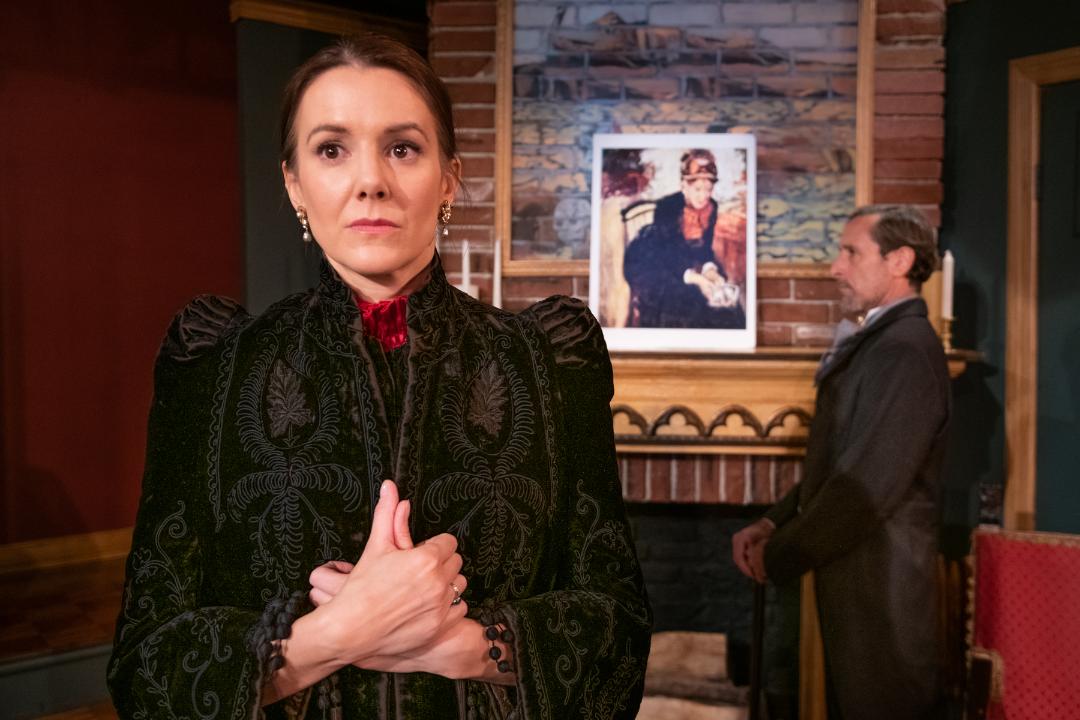

Nicole Lowrance & Jonathan Hadary
by Marilyn Lester
In the 1976 Oscar-winning film, Network, scripted by Paddy Chayefsky, “Howard Beale” (Peter Finch) famously leans out his apartment window, and urging others to do the same, shouts, “I’m mad as hell and I’m not going to take it any more!” In 1955, when Middle of the Night takes place, this protest is a silent scream – unspoken, and mostly unacted upon, but none the less intensely felt by each of play’s characters.
As the lights rise on The Girl (Betty), played with easy nuance by Nicole Lowrance, it’s clear she’s upset, fretting, conflicted. She’s also sleeping on the couch in her mother’s apartment. Shortly thereafter, at The Manufacturer’s apartment (Jerry Kingsley, played with sensitivity by Jonathan Hadary), angst, despair and conflict are also revealed. Over the course of three months, from November 1955 to February 1956, in scenes alternating between The Mother’s apartment and The Manufacturer’s apartment, two families will exert tremendous pressure on the two protagonists to conform.
Steven C. Kemp’s set, a comfortable but formal living room, perfectly captures the constrained era of the 1950s. Using a single chandelier to distinguish between The Manufacturer’s apartment, and The Girl’s, the uniformity of the set becomes a metaphor for the stagnancy of the characters’ lives. The frequent mention of snow throughout the play, mostly in relation to Jerry, is also metaphoric. In “the winter of one’s life,” the snow is either crisp and fresh and liberating or cold, wet and oppressive.
Paddy Chayefsky, one of the most renowned and innovative writers of the 1950s, cut his teeth during the so-called “Golden Age of Television.” Middle of the Night originally debuted in September 1954 on the Philco Television Playhouse. It moved to Broadway 15 months later where it had a respectable run and a national tour. It was filmed in 1959 by Columbia Pictures. As Chayefsky went on to greater fame in television, film and novels, his direct, character-driven works most always reflected his style of “slice of life” naturalism.
Jerry Kingsley, like other Chayefsky protagonists, is a middle-class tradesman struggling with the personal problems of a mid-life crisis, and under pressure to conform to the expectations of those around him. Jerry is a widower. He’s lonely and depressed, despite two grown children, the unseen Paul, and the overly attached Daughter (Lillian, played by Melissa Miller). The Sister (Evelyn, played by Denis Lute) has moved into Jerry’s apartment to “look after him.”
Betty is Kingsley’s mirror image in almost every way. She too is chafing against the expectations that society has imposed on her. Betty, Kingsley’s receptionist at his place of business, has sought refuge from a marriage in which her husband’s only interest is her body. Betty calls in sick from work, but realizes she has some necessary papers in her handbag. To her great surprise, the boss himself – who lives in the same Upper West Side neighborhood – comes to pick them up. On the level playing field of home turf, Jerry and Betty click. Something powerful is about to happen.
Both Jerry and Betty believe in Love. He’s a decent guy who, for instance, can’t accept the desperate and whoring lifestyle of his 60-year old business partner. Jerry is kind and caring. He says “I’m a man who has to give of himself.” Betty wants such a man; her husband, George, a jazz musician, is anything but caring and giving. Betty quite clearly sees what Jerry can offer.
In fact, Jerry and Betty are soul mates. The “problem” is, he’s 53, and a Jewish garmento. She’s 24 and gentile – and she’s about to become (gasp) a divorcee via a quick Mexican divorce. Jerry is also nothing to look at and she’s a blonde “looker.” The original roles of Kingsley and Betty were played by E.G. Marshall and Eva Marie Saint (TV), Edward G. Robinson and Gena Rowlands (stage), and Frederick March and Kim Novak (film).
When Middle of the Night debuted it was considered somewhat shocking with its May-December theme, frank talk about sex, and the rebelliousness of its main characters against how respectable folk are expected to behave. Although a bit dated in the present, modern era of personal freedom and sexual awareness, the underlying themes in Middle of the Night still show through in true colors. Tolerance is chief among them. The Cast is generically listed by Chayefsky as The Girl, The Mother, The Manufacturer, The Sister, and so on. Even though, within the text of the play, these characters have names, it’s clear Chayefsky regards each an “everyman” bearing the weight of universal truths.
Jerry’s family tries to show him the error of his ways. The 1950’s perception of age is reflected in Jerry’s lament that at age 53, “my life is coming to an end.” Evelyn and Lillian throw the book at him: what will happen in ten years, what if she wants a child, how will you keep up, and so on? A few blocks away, Betty’s family and friends tell her marriage isn’t about happiness, it’s about duty. Her mother tells her, “you’ve made your bed and now you have to lie in it,” urging her to stay with her husband. The 17-year old Kid Sister (Alyssa May Gold) hasn’t got much to say throughout the play, but takes all of this on board – her turn at life will eventually come.
The Husband, George (Todd Bartels), who’s been playing a gig in Las Vegas all this time, shows up to seduce Betty back into his life and his bed. He admits he doesn’t want her to get a divorce because his manhood in front of his friends will be compromised. As George imposes his physicality on Betty, she’s almost tempted, but it’s a turning point. She flees to Jerry’s apartment in the middle of the night.
In truth, Betty is a little naïve. Jerry acknowledges this and understands she is not unlike his own 25-year old daughter. Jerry, older, wiser, is aware of the potential folly of his situation. He admits he’s afraid. He has doubts about the relationship. But it’s Betty’s naiveté that is ultimately the driving force in making her union with Jerry a reality. Betty believes, and after she’s tested, she knows. It’s at this point that Betty achieves her womanhood, and Jerry sees it.
At 1:30 am in The Manufacturer’s apartment, The Girl makes her case and Jerry is convinced about the kismet of their relationship. Enough is enough. Betty and Jerry know they are made for each other. They’re not going to take “it” any more. Giddy with love and their decision to marry come what may, they leave Jerry’s apartment for a celebratory late-night walk in the snow – their future before them.
Director Jonathan Silverstein advances the dialog-driven action with straight-ahead confidence. Jonathan Spencer’s lighting subtly and wisely exploits the nuances of expression inherent in the play’s text. Costume designer Jennifer Paar is spot-on in her gorgeous dressing of her characters with period perfection to the last detail. Composer/Sound Designer is Obadiah Eaves and Props Designer is Ricola WIlle.
Middle of the Night – The Keen Company – plays through March 29 at the Clurman Theater on Theater Row; 410 West 42nd Street. 212-239-6200, telecharge.com.
*Photo: Carol Rosegg






















